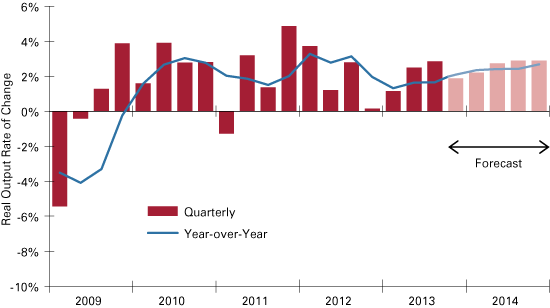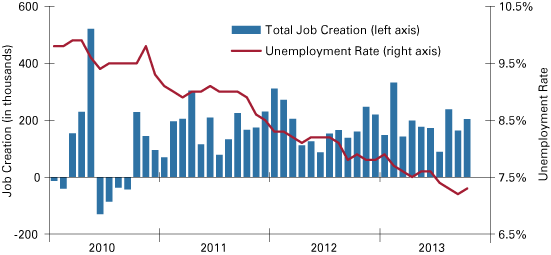U.S. Outlook for 2014
Professor Emeritus, Department of Economics, Indiana University Bloomington
The United States economy has continued to disappoint so far in 2013. Through the third quarter, the economy managed to grow at an annual rate of just 2.2 percent (see Figure 1).
Figure 1: U.S. Real Output Rate of Change, 2009 to 2014

Source: Bureau of Economic Analysis
Compared with our expectation a year ago, growth for all of 2013 will probably fall short by close to a full percentage point. The labor market has done somewhat better. We anticipated job growth would average close to 170,000 jobs per month. Through October 2013, the actual outcome has been 186,000 jobs per month (see Figure 2).
Figure 2: U.S. Monthly Job Creation and Unemployment Rate, 2010 to 2013

Source: Bureau of Labor Statistics
If the final two months come in similar to the past three, the full year will be slightly above our estimate. The unemployment rate was down to 7.3 percent in October. By year-end it could fall a little more, which would put it lower than we expected a year ago. However, this is partly because people have continued to drop out of the labor force. The employment rate (the ratio of those employed to the population) is currently at its lowest level in over three decades.
Looking at a longer time frame of data, the past decade can be broken into four different phases
Phase 1: The pre-recession period (2004–2007). During phase 1, the economy stumbled into a set of serious imbalances. The prime movers were the huge housing boom and an associated financial bubble. These fueled unsustainable levels of consumption (as households cashed out inflated home equity) and state and local spending (paid for with inflated property tax revenue).
Phase 2: The Great Recession. When the inevitable collapse occurred, the second phase began. This was the Great Recession, after which the economy needed to rebalance itself. Rebalancing required a set of painful adjustments: housing and local government needed to significantly downsize and consumption needed to downsize—a little in the long run and more in the short-term—as households saved in order to rebuild their balance sheets.
Phase 3: Stimulus and Stall. Unfortunately, these adjustments were hampered by government policy. The huge stimulus package tried to prop up housing and stimulate consumption. It augmented state and local revenues. This produced some temporary improvement in the first year after the recession, followed by a swoon when the programs ended. The stimulus and stall lasted through 2010.
- Phase 4: Healing. During the fourth phase, the economy has finally been moving on with its healing process. Housing has downsized, and during the past year and a half has come back to life. Households have made large strides toward balance sheet repair, especially those with exposure to equity markets. State and local finances in aggregate are much improved but some problems remain, particularly in certain larger cities.
For at least the past year, the economy should have been able to achieve growth close to, perhaps above, its long-run potential of 2.5 percent to 3.0 percent. Yet growth remains stuck in a sub 2 percent rut. We can find only one plausible explanation: policy from Washington is standing in the way all across the board. Fiscal policy is obviously a mess. The latest episode managed to kick that mess into next year, but only after shutting down much of the government for two weeks. On the regulatory front, the rule seems to be “if it succeeds, regulate it or sue it.” Meanwhile the Federal Reserve continues a totally unsustainable policy stance, with no real plan for how or when it will change course. All of this has created great uncertainty for consumers and greater uncertainty for businesses. Even with an improved financial situation, households remain reluctant to spend. Meanwhile, businesses sit on piles of cash, borrowing is cheap, yet investment spending is extremely disappointing.
Looking to 2014, this policy headwind is unlikely to disappear entirely, but it could possibly abate as the year unfolds. As a result, we expect that the first half of 2014 will be generally similar to the past year: unacceptably slow growth, without much progress in the labor market. To be more specific:
We expect output growth to average about 2 percent through mid-2014. In other words, déjà vu. Later in 2014 we think (hope, with our fingers crossed) that there will be some improvement and growth will rise to nearly 3 percent (see Figure 1). This is predicated on some clearing of the uncertainty clouds.
Labor market progress will continue. Employment could show increases above 200,000 jobs per month by the end of 2014, implying an unemployment rate below 6.5 percent by the end of the year.
We expect inflation to remain well contained in 2014.
The housing sector has been in recovery mode since the end of 2011 with very rapid growth over the past year. During 2014, we believe this surge will moderate. Housing will remain the strongest industry in the economy, but its period of double-digit growth could end.
The Federal Reserve has held short-term interest rates at virtually zero for almost five years and has said it will maintain this stance through mid-2015. It has also been buying about $85 billion in securities per month for nearly a year. We expect the latter will taper down during 2014, producing some disorder in financial markets, but with little impact on the rest of the economy.
- Any real actions on the fiscal policy would be welcome but also unexpected, at least to us.
Like a year ago, there are the usual suspects that could adversely upset our expectations. To begin with, the better economy later next year is predicated on some progress with the policy deadlock in Washington. Secondly, the outcome when the Fed begins to unwind its security purchase/low interest rate regime is very difficult to predict. Thirdly, the external situation is a minefield: Europe still has problems; the slowdown in China could resume; and the Middle East could go critical.
Even so, we expect the economy will muddle through. Specifically, we expect tepid economic recovery to continue for another few quarters with the possibility of a stronger environment later in 2014.




